Forward runs to penetrate and support
This session is about encouraging forward runs to penetrate defensive lines, supporting runs to provide options once this line is broken, and to help organise defensive positioning.

| Area | Full pitch |
| Equipment | Poles, mini goals, full size goals |
| No. of Players | Minimum 12 + 2 Goalkeepers |
| Session Time |
Roughly one hour including rest breaks, Technical warm-up: 8mins, End-zone game: 3x4mins, Think vertical: 2x6mins, 11v11: 2x10mins |
This session is about encouraging forward runs to penetrate defensive lines, supporting runs to provide options once this line is broken, and to help organise defensive positioning.
In order to score goals, you need players willing to run and pass forward. With the growing number of teams looking to press high and play high defensive lines, having players with the ability to recognise different ways of getting in behind is critical to creating goalscoring opportunities.
This is a session that could be run every two to three weeks, or dependent on specifics of upcoming opponents (high pressing teams leaving lots of space in behind). We would usually run it on MD-3 (extensive day).
End-zone game
After a technical warm-up, including one-twos, up back through, and third-player runs, we move on to the first activity. We set up in a square 32yds x 32yds, with six-yard wide channels and 12-yard end zones, for an end-zone game with the goals turned around. Divide players into teams and set up for 6+GK v 6+GK. Points are scored by connecting eight passes [1a], or by advancing over the end line and scoring into the turned-around mini goals.
1a
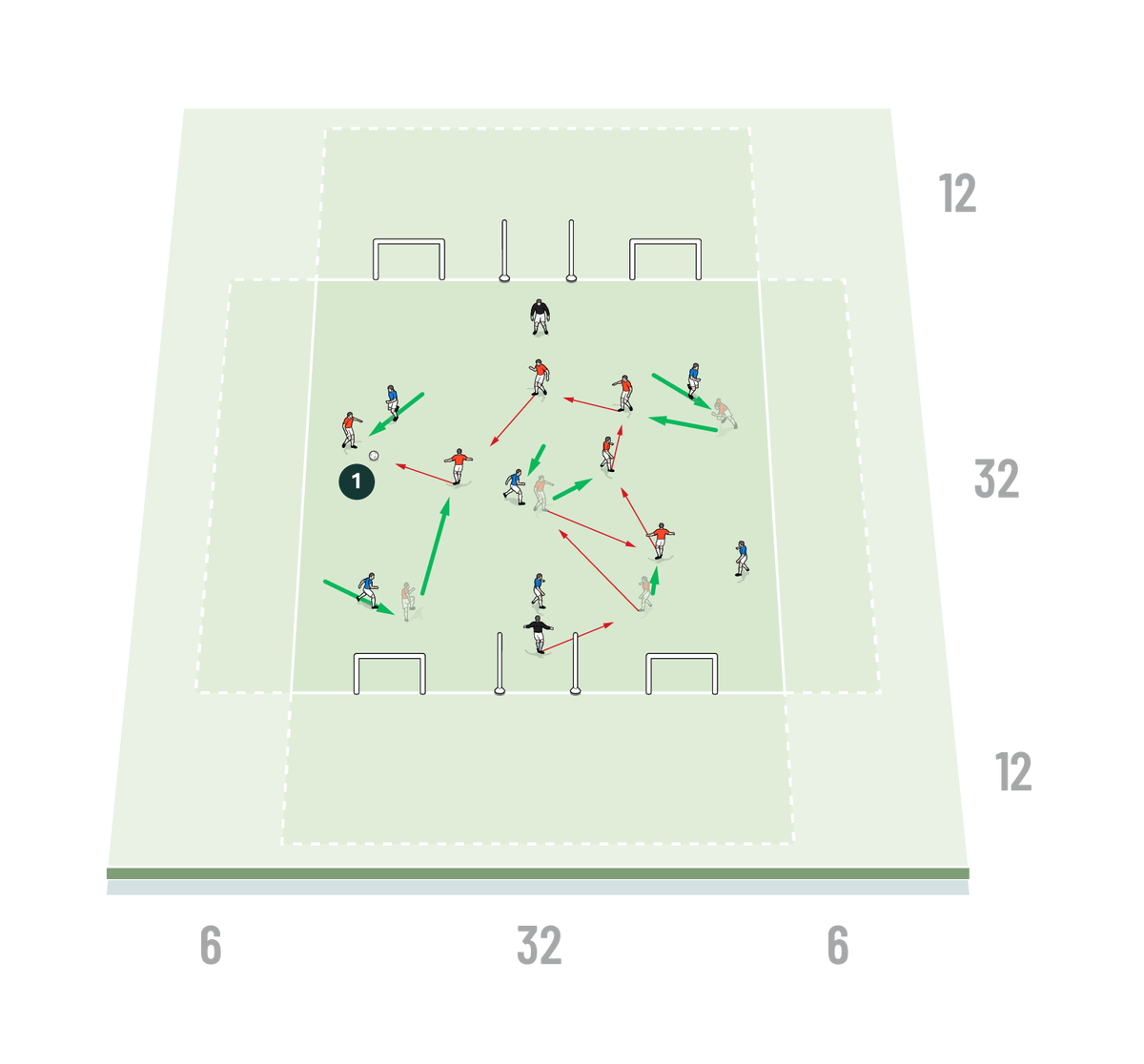
One attacking player can move into the wide channel unopposed, but must play a forward pass [1b].
1b
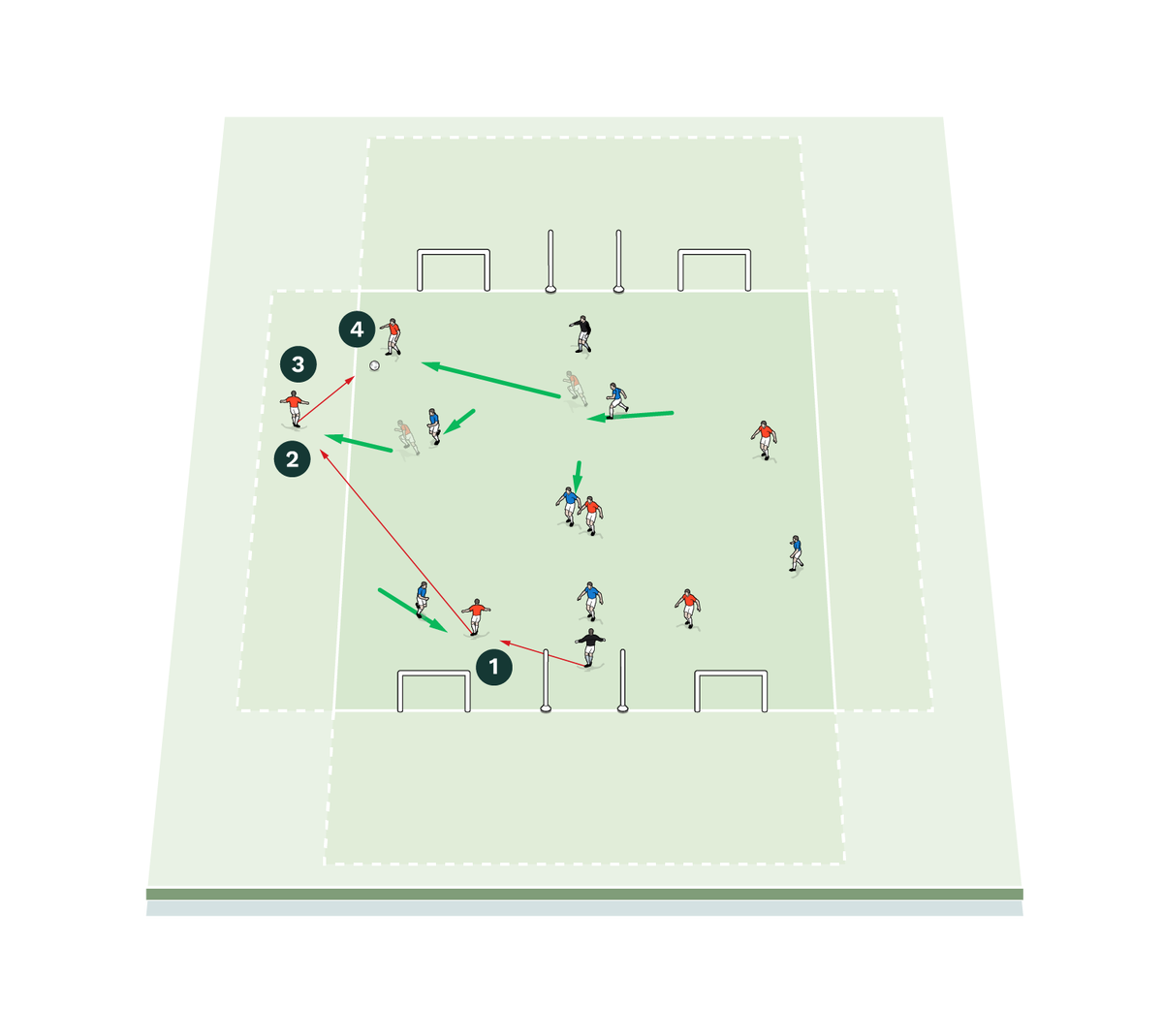
2. One player moves into wide channel
3. Wide player receives ball
4. Wide player plays forward pass
This encourages attacking players to make forward runs once the wide player receives the ball in this zone. Points can be scored through the poles that the goalkeeper can turn to defend [1c].
1c
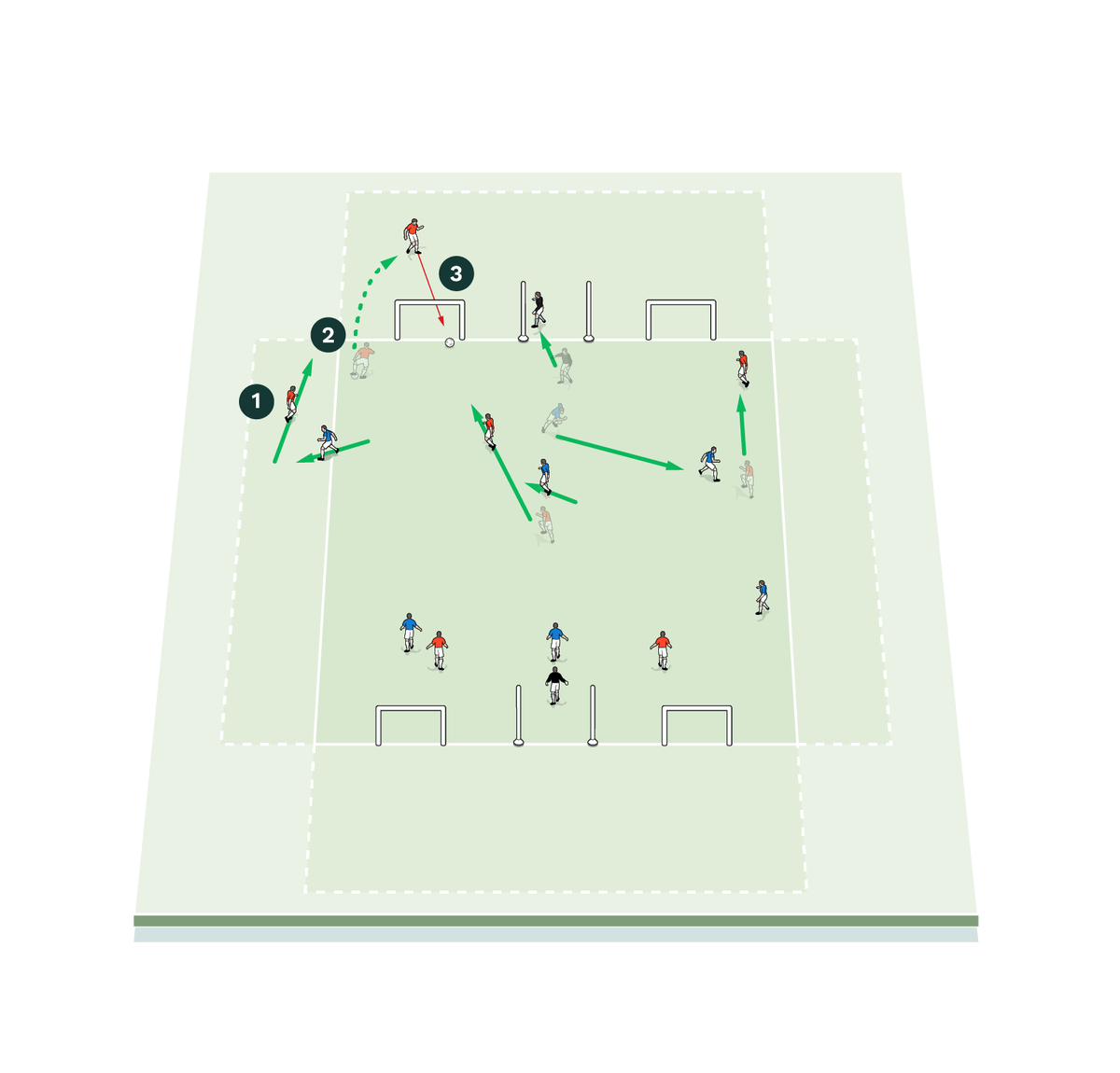
2. Red player advances over end line
3. Red player scores into mini goal
The end line is an offside line too. We award points for eight passes to encourage high pressing and to stop the defending team dropping too deep. Numbers can be adjusted, but we like using smaller numbers to begin with so the players get exposed to lots of opportunities to execute the desire actions.
With teams of six, this allows another group to work on another pitch on the same patterns of play, specifically to a full size goal. Rotating three teams of six allows for a “circuit”, which can be great for the main working day of the week.
Including the goalkeepers allows them to get reps in the build-up play and using poles in the middle makes a smooth transition to defend using their hands (with goals only scored from the end-zone). We run this for three sets of four minutes.
THINK VERTICAL
We set up in a space 50yds x 64 yds, with a 12-yard channel at one end. Set up 11v11 as shown. The red team can score points if they find a team-mate in a wide end-zone and connecting a pass out of the zone (two points) [2a], or finding the target (the blue goalkeeper) [2b], or receiving a pass (one point).
2a
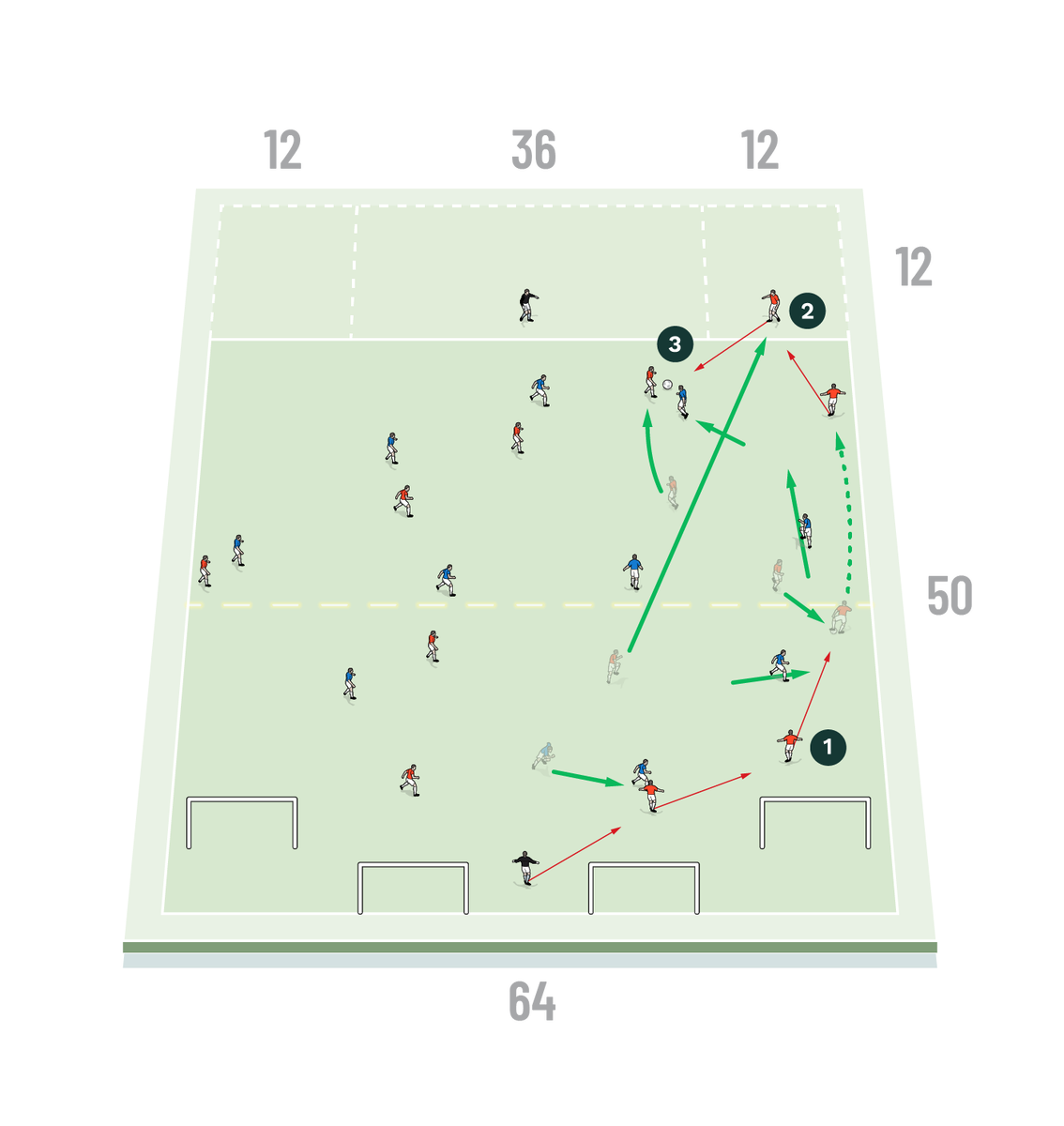
2. Red player moves into wide end-zone
3. Wide player receives ball and plays pass out
2b
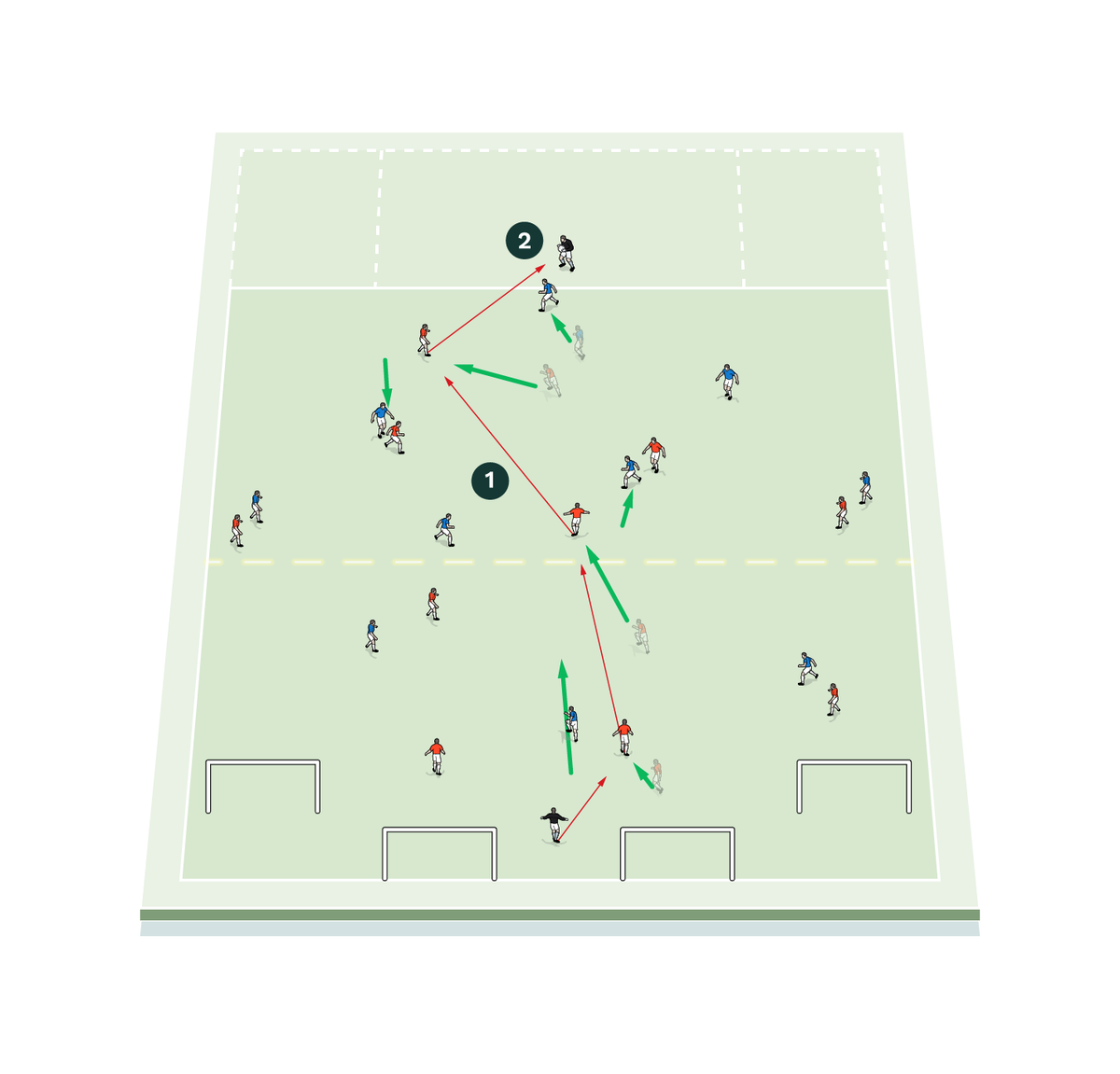
2. Red player finds blue GK
When the red team find the goalkeeper, a different red player has to receive back from the goalkeeper, to encourage supporting runs. The blue team can score points by scoring in one of the four mini goals (the red goalkeeper can only defend the two central goals) [2c]. We run this for two sets of six minutes.
2c
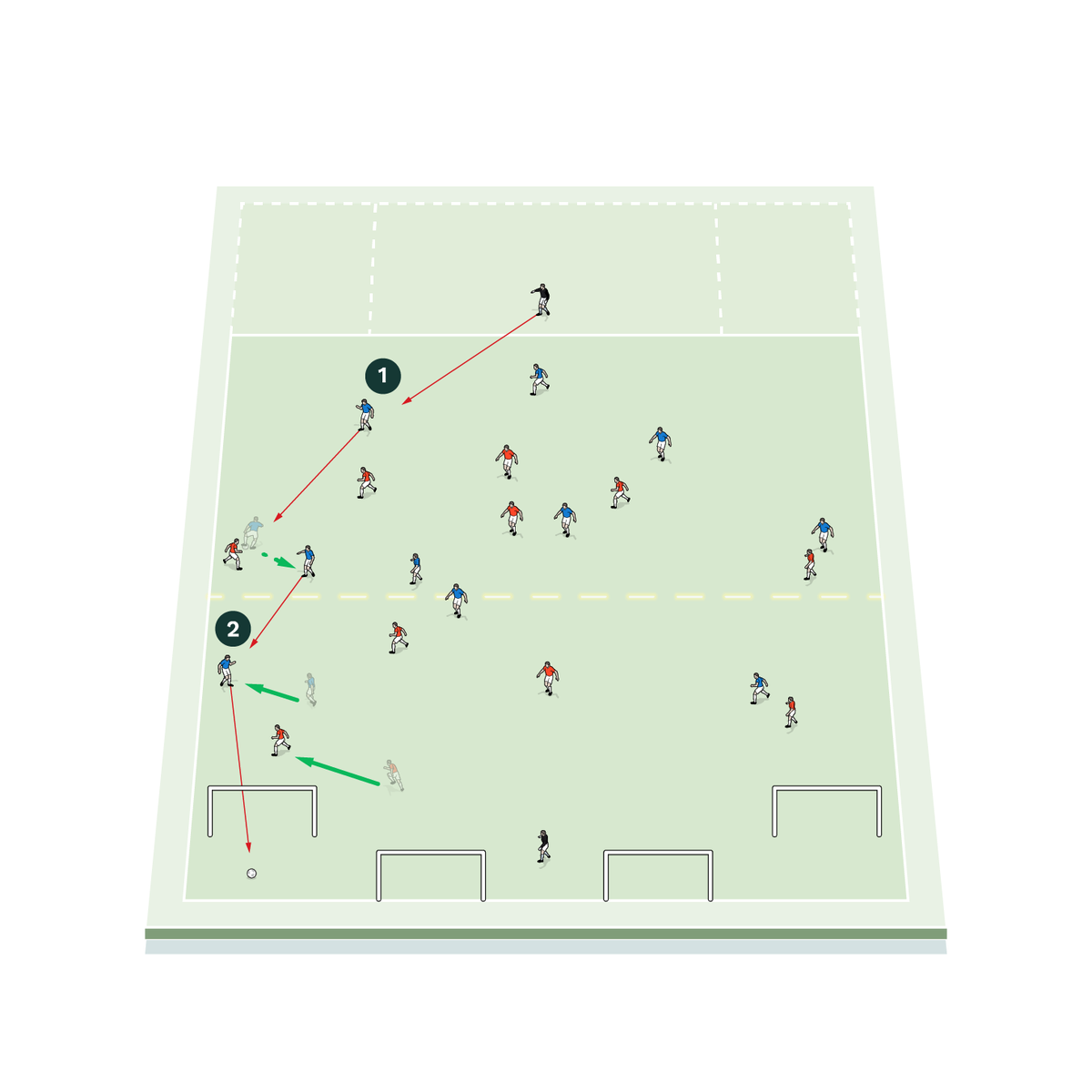
2. Blue team connect passes
3. Blue player scores in mini goal
11v11
Now we set up 11v11 in full game conditions.
The red team should have an emphasis on playing forward, penetrating the defensive line, and restricting themselves to three touches in their own half as they push into the opposition half, and unlimited touches once they advance over the halfway line, to encourage speed of play but also to push the blues to press them and hold a high defensive line. The blue team should have an emphasis on high pressing, playing a high defensive line; they can all operate everywhere, and are awarded two goals if they score from a regain in the final third.
We run this for two sets of ten minutes.
What are the key things to look out for?
In this session, we look for: different types of runs and passes to disrupt the defensive line (a straight pass with a diagonal run, a diagonal pass with a straight run); timing of runs; weight and detail of pass; angles to create opportunities to play one-twos to receive the pass running forward or in behind; up back through patterns involving the third player (opposite movements, soft sets, correct weight of forward pass so runners don’t break their stride); quick supporting runs to provide options for the player on the ball; organising rest defence positioning once the defensive line is broken to ensure connections between lines and effective counterpressing on loss of possession to lock the opposition in and start the next wave of attack. It is very important that the defensive team are managed correctly to press high and play a high line; constraints will help but having another coach to focus on this will be critical to ensure objectives are met.
What are the typical mistakes players might make and how do I avoid them?
Players may force passes in behind when not in an optimal position to do so; encourage a switch or double-switch of play if not on immediately (wide, then in behind). Players may get caught offside; look at coaching the timing and angles of runs in behind in the technical/unopposed part of the session.
Editor's Picks
Attacking transitions
Deep runs in the final third
Using the goalkeeper in build-up play
Intensive boxes drill with goals
Penetrating the final third
Creating and finishing
My philosophy
Pressing initiation
Compact team movement
Coaches' Testimonials

Alan Pardew

Arsène Wenger

Brendan Rodgers

Carlos Carvalhal

José Mourinho

Jürgen Klopp

Pep Guardiola

Roy Hodgson

Sir Alex Ferguson

Steven Gerrard
Coaches' Testimonials

Gerald Kearney, Downtown Las Vegas Soccer Club

Paul Butler, Florida, USA

Rick Shields, Springboro, USA

Tony Green, Pierrefonds Titans, Quebec, Canada
Join the world's leading coaches and managers and discover for yourself one of the best kept secrets in coaching. No other training tool on the planet is written or read by the calibre of names you’ll find in Elite Soccer.
In a recent survey 92% of subscribers said Elite Soccer makes them more confident, 89% said it makes them a more effective coach and 91% said it makes them more inspired.
Get Monthly Inspiration
All the latest techniques and approaches
Since 2010 Elite Soccer has given subscribers exclusive insight into the training ground practices of the world’s best coaches. Published in partnership with the League Managers Association we have unparalleled access to the leading lights in the English leagues, as well as a host of international managers.
Elite Soccer exclusively features sessions written by the coaches themselves. There are no observed sessions and no sessions “in the style of”, just first-hand advice delivered direct to you from the coach.









